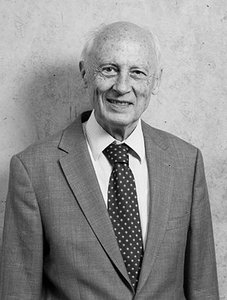Highlights
Publication Highlights
Coupling a sensory hair-cell bundle to cyber clones enhances nonlinear amplification
The vertebrate ear benefits from nonlinear mechanical amplification to operate over a vast range of sound intensities. The amplificatory process is thought to emerge from active force production by sensory hair cells. The mechano-sensory hair bundle that protrudes from the apical surface of each hair cell can oscillate spontaneously and function as a frequency-selective, nonlinear amplifier. Intrinsic fluctuations, however, jostle the response of a single hair bundle to weak stimuli and seriously limit amplification. Most hair bundles are mechanically coupled by overlying gelatinous structures. Here, we assayed the effects of mechanical coupling on the hair-bundle amplifier by combining dynamic force clamp of a hair bundle from the bullfrog’s saccule with real-time stochastic simulations of hair-bundle mechanics. This setup couples the hair bundle to two virtual hair bundles, called cyber clones, and mimics a situation in which the hair bundle is elastically linked to two neighbors with similar characteristics. We found that coupling increased the coherence of spontaneous hair-bundle oscillations. By effectively reducing noise, the synergic interplay between the hair bundle and its cyber clones also enhanced amplification of sinusoidal stimuli. All observed effects of coupling were in quantitative agreement with simulations. We argue that the auditory amplifier relies on hair-bundle cooperation to overcome intrinsic noise limitations and achieve high sensitivity and sharp frequency selectivity.
Jérémie Barral, Kai Dierkes, Benjamin Lindner, Frank Jülicher, Pascal Martin
PNAS 107 (18), 8079 (2010)
weiterlesenAwards and Honors
Stephan Grill wird mit dem Arches Award 2009 der Minerva Stiftung ausgezeichnet
Der Forschungspreis 'Award for Research Cooperation and High Excellence in Science' zeichnet deutsch-israelische Kooperationen aus und wird vom Bundesministerium für Bildung und Forschung finanziert.
weiterlesenAwards and Honors
Prof. Dr. Peter Fulde wird mit dem Tsungming Tu Award des National Science Councils, Taiwan geehrt
Der Tsungming-Tu-Preis wird verliehen vom National Science Councils Taiwan und ist die höchste akademische Ehre für Ausländer in Taiwan. Der erstmals 2007 verliehene Preis wird jährlich an höchstens drei Personen für außerordentliche Verdienste oder Entdeckungen in einem Forschungsgebiet vergeben und ist mit einem Preisgeld von zwischen 50.000 und 100.000 US-Dollar dotiert. Namensgeber ist der taiwanische Mediziner Tsungming Tu (1893–1986). Partnerorganisation des NSC für den Preis ist die Alexander von Humboldt-Stiftung.
weiterlesenPublication Highlights
Anisotropies in cortical tension reveal the physical basis of polarizing cortical flows
Asymmetric cell divisions are essential for the development of multicellular organisms. To proceed, they require an initially symmetric cell to polarize. In Caenorhabditis elegans zygotes, anteroposterior polarization is facilitated by a large-scale flow of the actomyosin cortex, which directs the asymmetry of the first mitotic division. Cortical flows appear in many contexts of development5, but their underlying forces and physical principles remain poorly understood. How actomyosin contractility and cortical tension interact to generate large-scale flow is unclear. Here we report on the subcellular distribution of cortical tension in the polarizing C. elegans zygote, which we determined using position- and direction-sensitive laser ablation. We demonstrate that cortical flow is associated with anisotropies in cortical tension and is not driven by gradients in cortical tension, which contradicts previous proposals5. These experiments, in conjunction with a theoretical description of active cortical mechanics, identify two prerequisites for large-scale cortical flow: a gradient in actomyosin contractility to drive flow and a sufficiently large viscosity of the cortex to allow flow to be long-ranged. We thus reveal the physical requirements of large-scale intracellular cortical flow that ensure the efficient polarization of the C. elegans zygote.
M. Mayer, M. Depken, J.S. Bois, F. Jülicher & S.W. Grill
Nature 467, 617 (2010)
weiterlesenPublication Highlights
Magnetically driven superconductivity in CeCu$_2$Si$_2$
The origin of unconventional superconductivity, including high-temperature and heavy-fermion superconductivity, is still a matter of controversy. Spin excitations instead of phonons are thought to be responsible for the formation of Cooper pairs. Using inelastic neutron scattering, we present the first in-depth study of the magnetic excitation spectrum in momentum and energy space in the superconducting and the normal states of CeCu$_2$Si$_2$. A clear spin excitation gap is observed in the superconducting state. We determine a lowering of the magnetic exchange energy in the superconducting state, in an amount considerably larger than the superconducting condensation energy. Our findings identify the antiferromagnetic excitations as the main driving force for superconducting pairing in this prototypical heavy-fermion compound located near an antiferromagnetic quantum critical point.
O. Stockert, J. Arndt, E. Faulhaber, C. Geibel, H.S. Jeevan, S. Kirchner, M. Loewenhaupt. K. Schmalz, W. Schmidt, Q. Si & F. Steglich
Nature Physics 7, 119 (2010)
weiterlesenAwards and Honors
Ehrenmitgliedschaft am Helmholtz-Zentrum Dresden-Rossendorf
Der Vorstand des FZD ernannte Prof. Peter Fulde während der Konferenz RHMF-2009 (Research in High Magnetic Fields) am 23. Juli 2009 zum Ehrenmitglied des FZD. Dies fand im Rahmen des Festaktes auf der RHMF-Konferenz statt, zu der sich gut 200 Wissenschaftler aus der ganzen Welt vom 22. - 25. Juli 2009 in der Dreikönigskirche in Dresden treffen. Die Konferenz wird ausgerichtet vom Institut Hochfeld-Magnetlabor Dresden des FZD. Die an den Festakt schließenden Vorträge beschäftigten sich durchweg mit dem Fulde-Effekt (FFLO), einem besonderen Zustand der Supraleitung, den Prof. Fulde bereits in den 1960er Jahren berechnet hatte, der aber erst vor kurzem experimentell bestätigt werden konnte - durch Wissenschaftler des Hochfeld-Magnetlabors Dresden.
weiterlesenPublication Highlights
Dirac Strings and Magnetic Monopoles in Spin Ice Dy$_2$Ti$_2$O$_7$
While sources of magnetic fields—magnetic monopoles—have so far proven elusive as elementary particles, several scenarios have been proposed recently in condensed matter physics of emergent quasiparticles resembling monopoles. A particularly simple proposition pertains to spin ice on the highly frustrated pyrochlore lattice. The spin ice state is argued to be well-described by networks of aligned dipoles resembling solenoidal tubes—classical, and observable, versions of a Dirac string. Where these tubes end, the resulting defect looks like a magnetic monopole. We demonstrate, by diffuse neutron scattering, the presence of such strings in the spin ice Dy$_2$Ti$_2$O$_7$. This is achieved by applying a symmetry-breaking magnetic field with which we can manipulate density and orientation of the strings. In turn, heat capacity is described by a gas of magnetic monopoles interacting via a magnetic Coulomb interaction.
D. J. P. Morris, D. A. Tennant , S. A. Grigera , B. Klemke , C. Castelnovo , R. Moessner , C. Czternasty , M. Meissner , K. C. Rule , J.-U. Hoffmann , K. Kiefer , S. Gerischer , D. Slobinsky,
R. S. Perry
Science 326, 411 (2009)
weiterlesenPublication Highlights
Generalized Models Reveal Stabilizing Factors in Food Webs
Insights into what stabilizes natural food webs have always been limited by a fundamental dilemma: Studies either need to make unwarranted simplifying assumptions, which undermines their relevance, or only examine few replicates of small food webs, which hampers the robustness of findings. We used generalized modeling to study several billion replicates of food webs with nonlinear interactions and up to 50 species. In this way, first we show that higher variability in link strengths stabilizes food webs only when webs are relatively small, whereas larger webs are instead destabilized. Second, we reveal a new power law describing how food-web stability scales with the number of species and their connectance. Third, we report two universal rules: Food-web stability is enhanced when (i) species at a high trophic level feed on multiple prey species and (ii) species at an intermediate trophic level are fed upon by multiple predator species.
T. Gross, L. Rudolf, S.A. Levin, U. Dieckmann
Science 325, 747 (2009)
weiterlesenPublication Highlights
Germline P Granules Are Liquid Droplets That Localize by Controlled Dissolution/Condensation
In sexually reproducing organisms, embryos specify germ cells, which ultimately generate sperm and eggs. In Caenorhabditis elegans, the first germ cell is established when RNA and protein-rich P granules localize to the posterior of the one-cell embryo. Localization of P granules and their physical nature remain poorly understood. Here we show that P granules exhibit liquid-like behaviors, including fusion, dripping, and wetting, which we used to estimate their viscosity and surface tension. As with other liquids, P granules rapidly dissolved and condensed. Localization occurred by a biased increase in P granule condensation at the posterior. This process reflects a classic phase transition, in which polarity proteins vary the condensation point across the cell. Such phase transitions may represent a fundamental physicochemical mechanism for structuring the cytoplasm.
C. P. Brangwynne, C. R. Eckmann, D. S. Courson, A Rybarska, C. Hoege, J. Gharakhani, F.Jülicher, A. A. Hyman
Science 324, 1729 (2009)
weiterlesenPublication Highlights
Magnetism: Monopoles on the move
Magnetic materials provide a new context for observing magnetic monopoles. Numerical simulations now establish an experimentally measurable signature of their dynamics - one that has in fact already been seen in a spin-ice compound.
R. Moessner and P. Schiffer
Nature Physics 5, 250 (2009)
weiterlesen


